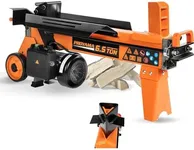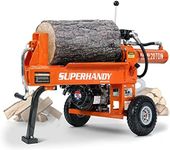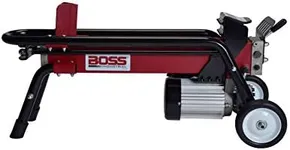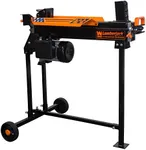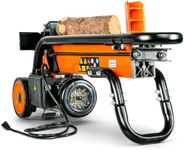Buying Guide for the Best Electric Log Splitters
Choosing the right electric log splitter can make your wood splitting tasks much easier and safer. The key is to match the splitter’s capabilities to the size and type of wood you’ll be working with, as well as how often you plan to use it. Understanding the main specifications will help you find a model that fits your needs, whether you’re preparing firewood for a small fireplace or handling larger logs for regular use.Tonnage (Splitting Force)Tonnage refers to the amount of force the log splitter can apply to split wood, usually measured in tons. This is important because it determines the size and hardness of logs the splitter can handle. Lower tonnage (around 4-7 tons) is suitable for small, softwood logs, while higher tonnage (10 tons or more) is needed for larger or hardwood logs. To pick the right tonnage, consider the typical diameter and type of wood you’ll be splitting. If you mostly split small, dry logs, a lower tonnage will suffice. For larger, green, or hardwood logs, opt for a higher tonnage to avoid the machine getting stuck or overworked.
Cycle TimeCycle time is the amount of time it takes for the splitter to complete one full split and return to its starting position. This matters because a faster cycle time means you can split more logs in less time, which is helpful for larger jobs. Cycle times can range from about 10 to 20 seconds. If you only split a few logs at a time, a longer cycle time may not be an issue. However, if you plan to split a lot of wood regularly, a shorter cycle time will make the process much more efficient.
Log Capacity (Length and Diameter)Log capacity tells you the maximum length and diameter of logs the splitter can handle. This is crucial because trying to split logs that are too large for your machine can be unsafe and may damage the splitter. Most electric log splitters can handle logs up to 20 inches long and 10-12 inches in diameter, but this varies. To choose the right capacity, measure the typical size of the logs you’ll be splitting and make sure the splitter can accommodate them comfortably.
PortabilityPortability refers to how easy it is to move the log splitter around. This is important if you need to transport the splitter to different locations or store it away when not in use. Features like wheels, handles, and overall weight affect portability. If you’ll be using the splitter in one place, portability may not matter much. But if you need to move it often, look for a lighter model with sturdy wheels and a comfortable handle.
Power Source and Cord LengthElectric log splitters need to be plugged into a power source, so it’s important to consider the length of the power cord and the availability of outlets where you’ll be working. A longer cord gives you more flexibility in where you can use the splitter, but you may still need an extension cord. Make sure the splitter’s power requirements match what you have available, and plan for safe, convenient access to electricity.
Safety FeaturesSafety features are designed to protect you while using the log splitter. These can include two-handed operation (which requires both hands to operate the machine, keeping them away from moving parts), automatic shut-off, and protective covers. Safety is always important, but especially if you’re new to using power equipment or if children or pets are nearby. Look for models with clear, easy-to-use safety features that match your comfort level and environment.
